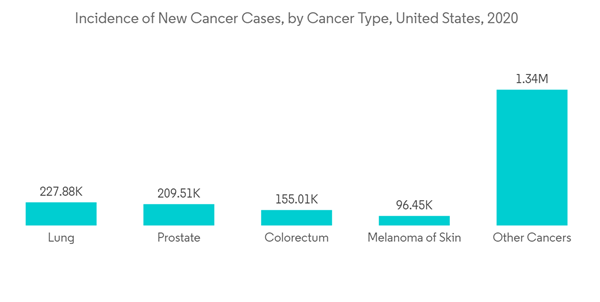Various research studies have been conducted on the impact of the Covid pandemic on retail clinics and pharmacies in the United States. For instance, in May 2020, a research study published titled" Impact of COVID-19 Leaves Lasting Impression on Pharmacies" stated that the coronavirus disease 2019 (COVID-19) pandemic is likely to leave a lasting impression on pharmacies and the services provided by pharmacists. States, such as California and Connecticut, are looking more to pharmacists to provide patient care services, including ordering and administering testing for COVID-19. In addition, the federal lifting of some regulations has made telehealth services possible for many pharmacies. Hence, the pandemic may have a short-term negative effect on the retail clinics but in the long term, the market is likely to grow. Similarly, in November 2020, another research study published titled "The impact of COVID-19 on pharmacy transitions of care services" stated that COVID-19 has necessitated alterations to the delivery of healthcare services. Modifications include those made to improve patient and healthcare worker safety such as the use of personal protective equipment. Pharmacy services, specifically pharmacy transitions of care services have not been immune to change which have brought along their own set of unique challenges to consider. While the direct impact of COVID-19 may be transient, there will likely be longer-term implications on how we provide patient care. With expanding utilization of telehealth services, and the increasing complexities of navigating the healthcare system, it remains essential to optimize provision of care as patients transition from one provider or setting to the next. Optimizing transitions of care interventions, and implementing strategies to support effective communication and interprofessional collaboration, will support providing continuity of care for patients.
Insurance coverage is one of the key factors for the growth of the market as there is a hug population that would invest in health insurance in upcoming years as many still dont have any health insurance. For instance, according to the United States Census Bureau, around 26.1 million Americans-i.e., almost 8% of the US population-didn't have health insurance at any point during 2019. For people in this bracket, healthcare is an out-of-pocket cost that can even turn into a large medical debt. These people want low-cost healthcare services that don't require insurance, and retail clinics offer one such option. Intiatives by key market players are another factor for the growth of the market. For instance, in May 2021, Walmart and Sam's Club announced a new COVID-19 vaccine milestone: Immunizations are now available to customers and associates in all of their more than 5,100 pharmacy locations nationwide, across 49 states, Puerto Rico and Washington, D.C. Vaccines are being administered via both walk-up and pre-scheduled appointments, providing convenient options for customers to get protected against COVID-19. Hence, due to above mentioned factors the market is likely to grow in the future.
However, relucatnce to visit retail clincs by genral population is one of the key hinderance for the growth of the market.
US Retail Clinics Market Trends
Point of Care Diagnostics are Expected to Hold a Significant Market Share Over the Forecast Period
Point of care diagnostics holds the largest shares in the market, owing to presence of better healthcare infrastructure, increasing cases of infectious diseases, a growing geriatric population base, and high-quality diagnostic tests that are widely available. According to the estimates of the American Cancer Society, in 2021, an estimated 1,898,160 new cases of cancer may be diagnosed in the United States, and 608,570 people may die from the disease. In the future, this number may increase insignificantly over the year, which is expected to drive the growth in the studied market in the country. According to the Centers for Disease Control and Prevention report of 2019 on infectious diseases, there were 9,025 new cases of tuberculosis, 60,999 new cases of salmonella, 33,666 new cases of Lyme disease, and 327 new cases of meningococcal disease in 2018. For the primary diagnosis of infectious and parasitic diseases, the number of visits to the physician's office was 15.5 million. The rising prevalence of chronic diseases may significantly drive the studied market in the United States. Additionally, chronic diseases such as heart disease are a leading cause of death that creates an enormous burden on people, communities, healthcare providers, and systems. According to the American Heart Association Research Report 2021, between 2015 and 2018, around 126.9 million American adults had some form of cardiovascular disease (CVD); this indicates the increased use of therapeutics for cardiology-related issues may boost the market over the studied period.Therefore, access to sensitive and rapid infectious disease diagnostic assays is essential for accurate diagnosis, effective treatment, and timely infection control, making point-of-care tests vital to reducing turnaround time and promoting the growth of retail clinics in the market.
US Retail Clinics Industry Overview
A few of the major players currently dominating the industry in terms of revenue are Walmart, AtlantiCare, Bellin Health (Fastcare), Aurora Health Care, Inc., and Walgreens among others.Additional Benefits:
- The market estimate (ME) sheet in Excel format
- 3 months of analyst support
This product will be delivered within 2 business days.
Table of Contents
Companies Mentioned (Partial List)
A selection of companies mentioned in this report includes, but is not limited to:
- Access Health
- AtlantiCare
- Aurora Health Care, Inc.
- Bellin Health (Fastcare)
- CVS Health (MinuteClinic)
- Kroger (Little Clinic)
- RiteAid (RediClinic)
- Walgreens
- Walmart









